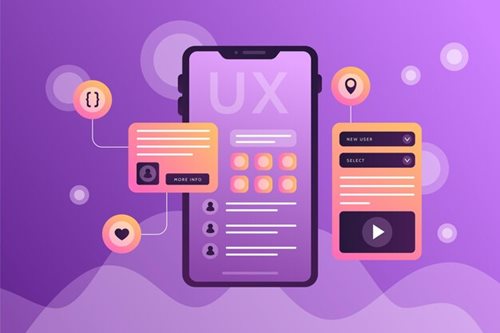Get your free consultation today!
Share with your Colleagues
Categories
ROI Calculator
Moonstone Interactive is the only San Francisco Bay Area web design firm and Internet Marketing expert that offers a free online ROI Calculator
Author: Steve Herz

User experience (UX) is vital to customer satisfaction and business success in today's digital landscape. Web development is essential for creating user-friendly websites that are engaging and easy to use.
We discuss the connection between web development and UX, the design process, new technology, and the benefits of using a professional web development firm. This article is helpful for business owners, web developers, and anyone who wants to improve User Experience.
Understanding User Experience in Web Development
User Experience (UX) in web development is about how a user interacts with a website. When users find what they want quickly and easily, they are optimistic about the experience and the brand.
UX is about the entire journey when navigating a website. Every click, scroll, and interaction matter from the moment a user lands on a website. These actions shape the user's experience and perception of the brand.
The Definition and Importance of UX
User Experience (UX) is the user's interaction with a company, its services, and its products. In web development, UX creates an easy-to-use, intuitive website that meets users' needs.
We cannot overstate the importance of UX in web development. A user-driven website will deliver a positive user experience, increase engagement, customer satisfaction, and conversion rates.
Moreover, a good UX design can help a website rank higher in search engine results. Search engines like Google apply user experience as a ranking factor. This means that websites with a positive user experience should appear higher in search results, driving more organic traffic to the site. Therefore, investing in UX cannot only improve customer satisfaction but also boost a website's visibility and online presence.
The Impact of UX on Business and Customer Satisfaction
A positive user experience is a game-changer for business results. Satisfied users make purchases and return and spread the word about a website they love. When customers have a positive experience with a website, they become loyal customers and advocates for the brand, driving business success.
In contrast, a poor experience can result in high bounce rates, representing the percentage of visitors exiting a website after viewing only one page, low conversion rates, fewer website visitors completing the desired actions, and a poor online reputation. Harmful UX can harm a business's bottom line by significantly losing potential customers and revenue.

The User Experience Design Process
The user experience design process is a crucial aspect of web development. UX design includes understanding the user's needs, creating a design that meets them, testing, and refining the design based on user feedback.
UX design requires a continuous learning cycle. It involves designing, testing, and refining. The goal is to create a seamless, enjoyable user experience and attractive site. This iterative process empowers web developers to improve and enhance the user experience constantly.
The user experience design process often involves using various tools and techniques. These may include user research, persona creation, user flow mapping, wireframing, prototyping, usability testing, and more.
Key Principles and Stages
Several fundamental principles guide the user experience design process. The process typically involves several stages.
The first stage is research, where the designer seeks to understand the user's needs, goals, and behaviors. Research may include conducting surveys, interviews, or usability tests.
The next stage is design, where the designer creates a website prototype based on the insights gained from the research stage. This prototype is then user-tested, feedback is gathered, and any issues or areas for improvement are identified.
The final stage is refinement, where the designer changes the design based on the feedback received.
User experience design tests and improves until it meets the user's needs and creates a good user experience.
Persona-Driven Design and User Behavior
Persona-driven design is a technique used in the user experience design process. It involves creating fictional characters, or personas, that represent the different user types that might use a website.
Personas define user groups with similar needs, goals, behaviors, and pain points. They help the designer to understand the user's perspective and design a website that meets their needs.
Understanding user behavior is also crucial to the user experience design process. Study how users interact with a website, what actions they take, and what problems they encounter. Use these insights to improve the design and create a better user experience.

The Role of Web Development Companies in UX
Web development companies contribute significant value shaping the user experience. They bring together a team of experts, including UX designers, marketers, developers, and project managers. UX designers, in particular, are responsible for understanding user needs, creating intuitive designs, and testing and refining them based on user feedback. Their role is crucial in ensuring a website exceeds users' needs and provides a positive user experience.
Web development agencies understand the importance of UX in web development. They follow a user-centric approach, which means that they design and develop websites with the user's needs and preferences in mind. This approach involves understanding the user's perspective, creating a design that meets their needs, testing for feedback, and then refining the design based on user response. By putting the user at the center of the design process, these companies can create websites that are intuitive, easy to use, and provide a positive user experience.
Web development companies also provide a wealth of experience and expertise. They have broad experience from various projects and deeply understand the best practices and trends in UX design. Professional web development companies create websites that look good and provide a seamless and enjoyable user experience.
Finally, web development companies can provide ongoing support and maintenance. They can help keep the website up-to-date and evolve the site to maintain a positive user experience. As users' needs and behaviors evolve, web development updates the website to meet changing requirements.
Choosing the Right Web Development Partner
Choose the right web development partner to enrich the user experience. A good partner knows your business needs, understands UX design well, and has a history of successful projects.
When considering a web development partner, consider their breadth of experience and expertise. Look for a company that has worked on various projects and has a strong portfolio of work. Often, the best solutions for your business may be related experience in a different industry.
A professional development agency will have proven processes and methods for UX design. It will take a user-centric approach and industry-best-practice tools and techniques to test and refine its designs.
Case Studies: Success Stories from Top Companies
Case studies, such as the one we'll explore later, show how a web development company creates good user experiences through successful UX design. They offer valuable insights and practical examples of how UX principles can be applied in real-life scenarios.
Case studies can also show how a web development company uses user research to understand users' needs. They then created a solution to meet those needs and made improvements based on user feedback. Experimentation provides valuable insights into user expectations and experience.
Technologies Enhancing UX: DXP and Composable DXP
In web development, technologies are constantly evolving to enhance user experience. One such technology is the Digital Experience Platform (DXP). DXPs are comprehensive software frameworks that provide a range of tools to deliver personalized, omnichannel user experiences. They integrate various digital tools and technologies, such as content management systems, analytics, and personalization engines, to build a consistent user experience across multiple channels and devices.
DXPs manage and deliver content, integrate with other systems, and provide analytics. Businesses often use them to create and manage websites, mobile apps, and other digital experiences. DXPs are changing the game by improving user experience through personalized and seamless interactions with the user.
Understanding DXP Platforms 
A Digital Experience Platform (DXP) is a software suite that helps businesses manage content and optimize digital experiences. DXP tools enable companies to evolve consistently across every phase of the customer lifecycle. This next-level CMS integrates various technologies to provide a seamless, personalized user experience.
Businesses use DXPs to provide a consistent user experience across multiple channels. They integrate with various systems, including content management, e-commerce, marketing automation, and customer relationship management. A modern DXP enables businesses to fulfill seamless and personalized user experiences across all touchpoints to increase conversions.
The Advantages of Composable DXP
Composable DXP is a more flexible approach to digital experience platforms. It allows businesses to select and assemble various components based on their specific needs. Modular architectures enable companies to change and evolve their digital experiences as their needs change.
Composable DXP offers several advantages. Businesses can select the components that best meet their users' needs. It also allows for faster innovation, as companies can easily add or replace components as new technologies emerge. Finally, it can save costs, as businesses only pay for the necessary components.
Information Architecture and User Interface Design
Information architecture (IA) and user interface (UI) design are two critical aspects of web development that significantly impact user experience. IA is the website organization and structure, while UI design is the visual elements that users interact with.
A well-designed information architecture facilitates users' quick finding of what they want. On the other hand, an intuitive user interface guide users' interaction with the website effectively and efficiently.

Crafting Intuitive Information Architecture
Information architecture is the backbone of a website. AI organizes and structures information in a way that is easy to use and accessible to users. A well-crafted information architecture allows users to navigate a website easily, enhancing their overall experience.
Crafting an intuitive information architecture involves understanding the user's needs and behaviors. Successful companies conduct user research, create personas, and test users. The goal is to create a structure that aligns with the user's mental model, making it easy for them to find what they want.
A good information architecture should be scalable and flexible, allowing future growth and changes. It should also be consistent, with a clear and logical structure that users can easily understand.
The Relationship Between UI Design and UX
User interface design is an fundamental component of delivering user experience. UI involves designing the visual elements of a website, such as buttons, menus, and forms. An intuitive user interface compels users to interact with a website, enhancing their overall experience.
The UI design should be consistent and predictable, making it easy for users to learn and use. It should also be responsive, ensuring the website functions consistently while effectively optimizing different devices and screen sizes.
The UI design should also consider the user's needs and preferences. It involves understanding the user's behavior, preferences, and needs and designing the interface to meet them. Successful companies achieve optimal results through user research, persona creation, and user testing.
Best Practices for Web Development and UX

Web development and user experience (UX) work together. A well-developed website that elevates UX can significantly enhance user satisfaction and engagement. Here are some best practices that can help improve both web development and UX.
Mobile Responsiveness and Accessibility
In today's digital age, mobile responsiveness is no longer an option but a necessity. Make sure your website works well on all screen sizes, especially with more people using mobile devices. Responsive design improves the user experience and elevates your website's search engine ranking.
Accessibility is a foundational aspect of web development and UX. All people, including those with disabilities, can use an accessible website. Ensure your website enables assistive technologies and satisfies the Web Content Accessibility Guidelines (WCAG).
By delivering mobile responsiveness and accessibility, you enable usability for a broader audience, thereby improving the overall user experience.
Visual Design and Micro-Interactions
Compelling visual design enhances the user experience. A visually appealing website attracts and retains users, leading to higher engagement and conversion rates. Visual appeal involves using appropriate colors, typography, images, and layout aligning with your brand identity and target audience.
Micro-interactions are another essential aspect of UX. These are small, subtle animations or design elements that guide users and provide feedback. For example, a color-changing button or progress animation provides visual feedback to the user. Micro-interactions can deliver more engaging and intuitive user experinces.
Visually appealing design elements and effective micro-interactions enable an attractive website with a superior user experience.
The Future of UX in Web Development
The future of UX in web development is promising and exciting. With rapid technological advancements, how we interact with websites evolves. This evolution drives the need for more innovative and user-centric web development practices.
Artificial Intelligence (AI) and Machine Learning (ML) adoption is growing and can accelerate UX solutions. These technologies can provide personalized experiences, predict user behavior, and automate routine tasks, enhancing the overall user experience.
Emerging Trends and Technologies
One emerging trend in UX is the use of Virtual Reality (VR) and Augmented Reality (AR). These technologies can provide immersive experiences that can take user engagement to a new level. Another trend is using voice user interfaces (VUIs), which allow users to interact with websites using voice commands.
Blockchain technology is also making its way into web development. Secure, transparent, and efficient transactions can enhance the user experience. These emerging trends and technologies will redefine the future of UX in web development.
Preparing for the Next Wave in UX
Businesses and web developers must stay updated with the latest trends and technologies. Preparation involves continuous learning, experimentation, and adaptation. It is crucial to keep the user at the center of all development efforts.
Moreover, businesses should consider partnering with a web development company specializing in UX. A professional development company will help create a website that meets current UX standards and is ready for the future.
Conclusion: Integrating UX into Your Web Development Strategy
In conclusion, integrating UX into your web development strategy is no longer optional. Successful businesses stay competitive in the digital landscape, and a well-designed user experience can significantly enhance customer satisfaction, engagement, and business success.
Understanding your users' needs and behaviors is crucial to effectively integrating UX. This understanding will guide all aspects of your web development process, from information architecture design to technologies and platforms. Remember to test and refine your UX to identify changing user expectations.
Remember, a great user experience is a continuous process that requires ongoing commitment and investment. Emphasizing UX in your web development strategy will help you create a website that exceeds your users' expectations.
Moonstone Interactive is a certified developer for two industry-renowned DXP platforms: Kentico Xperience and Optimizely DXP. Contact Moonstone today for a free consultation!



